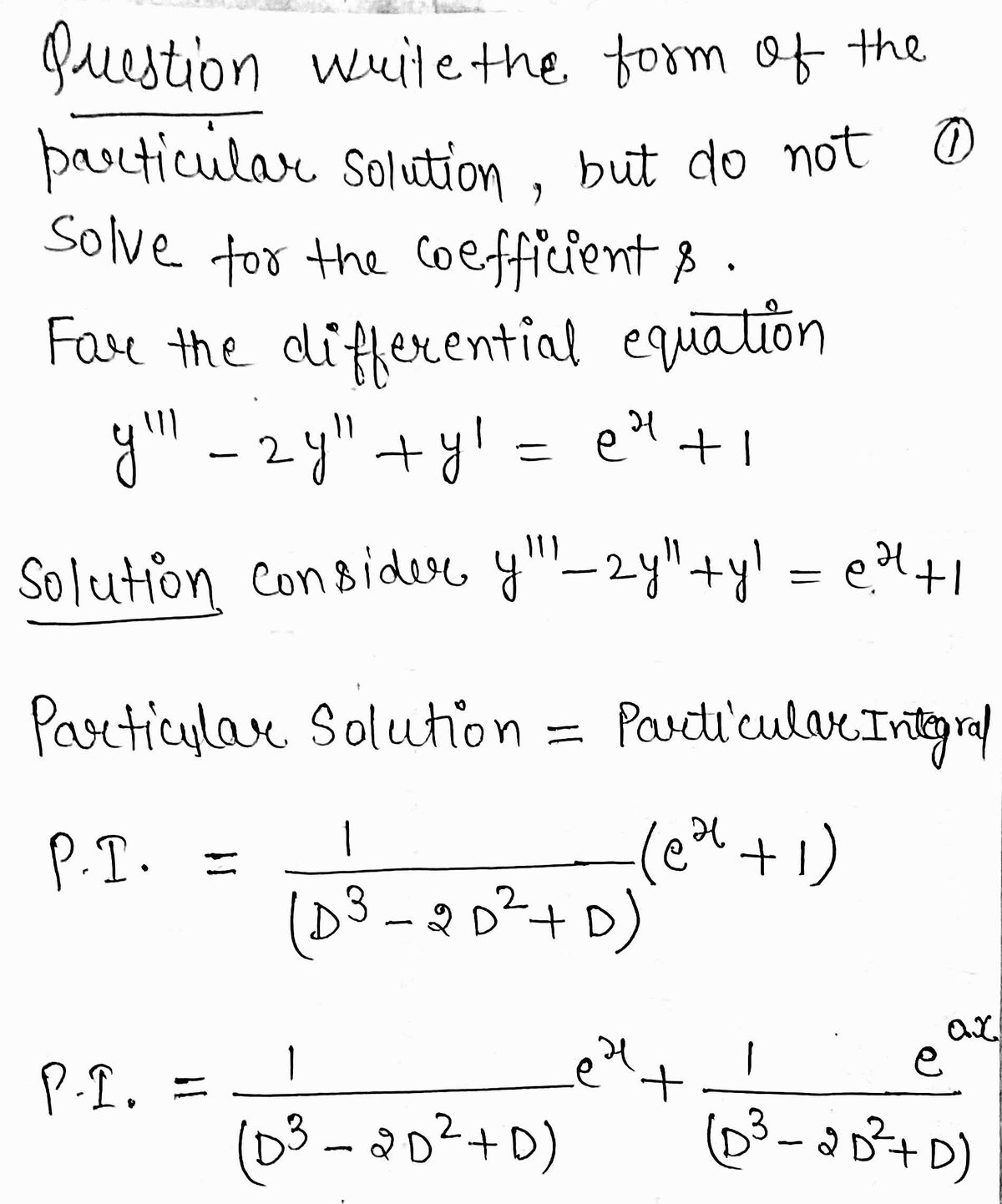Calculus: Early Transcendentals
8th Edition
ISBN:9781285741550
Author:James Stewart
Publisher:James Stewart
Chapter1: Functions And Models
Section: Chapter Questions
Problem 1RCC: (a) What is a function? What are its domain and range? (b) What is the graph of a function? (c) How...
Related questions
Question
![**Transcription:**
Write the form of the particular solution, but do not solve for the coefficients, for the differential equation
\[ y''' - 2y'' + y' = e^x + 1. \]
**Explanation:**
The image contains a mathematical instruction related to a third-order linear differential equation. The equation is \( y''' - 2y'' + y' = e^x + 1 \), where \( y''' \) represents the third derivative of \( y \) with respect to \( x \), \( y'' \) is the second derivative, and \( y' \) is the first derivative.
The task is to write the form of the particular solution of this differential equation. The right-hand side of the equation includes an exponential function and a constant. When proposing the form of the particular solution, you should account for these terms. Since the right side includes \( e^x \) and a constant term, one possible form of the particular solution could involve terms proportional to \( e^x \) and a constant.
However, the problem specifies not to solve for the coefficients, so only setting up the general form is required.](/v2/_next/image?url=https%3A%2F%2Fcontent.bartleby.com%2Fqna-images%2Fquestion%2Fa6cee183-215d-43ed-a508-06b044f7e9eb%2F7110921e-ec9c-49f2-ae6f-393600cebd50%2Fls7fpy5_processed.png&w=3840&q=75)
Transcribed Image Text:**Transcription:**
Write the form of the particular solution, but do not solve for the coefficients, for the differential equation
\[ y''' - 2y'' + y' = e^x + 1. \]
**Explanation:**
The image contains a mathematical instruction related to a third-order linear differential equation. The equation is \( y''' - 2y'' + y' = e^x + 1 \), where \( y''' \) represents the third derivative of \( y \) with respect to \( x \), \( y'' \) is the second derivative, and \( y' \) is the first derivative.
The task is to write the form of the particular solution of this differential equation. The right-hand side of the equation includes an exponential function and a constant. When proposing the form of the particular solution, you should account for these terms. Since the right side includes \( e^x \) and a constant term, one possible form of the particular solution could involve terms proportional to \( e^x \) and a constant.
However, the problem specifies not to solve for the coefficients, so only setting up the general form is required.
Expert Solution
Step 1

Step by step
Solved in 4 steps with 4 images

Recommended textbooks for you

Calculus: Early Transcendentals
Calculus
ISBN:
9781285741550
Author:
James Stewart
Publisher:
Cengage Learning

Thomas' Calculus (14th Edition)
Calculus
ISBN:
9780134438986
Author:
Joel R. Hass, Christopher E. Heil, Maurice D. Weir
Publisher:
PEARSON

Calculus: Early Transcendentals (3rd Edition)
Calculus
ISBN:
9780134763644
Author:
William L. Briggs, Lyle Cochran, Bernard Gillett, Eric Schulz
Publisher:
PEARSON

Calculus: Early Transcendentals
Calculus
ISBN:
9781285741550
Author:
James Stewart
Publisher:
Cengage Learning

Thomas' Calculus (14th Edition)
Calculus
ISBN:
9780134438986
Author:
Joel R. Hass, Christopher E. Heil, Maurice D. Weir
Publisher:
PEARSON

Calculus: Early Transcendentals (3rd Edition)
Calculus
ISBN:
9780134763644
Author:
William L. Briggs, Lyle Cochran, Bernard Gillett, Eric Schulz
Publisher:
PEARSON

Calculus: Early Transcendentals
Calculus
ISBN:
9781319050740
Author:
Jon Rogawski, Colin Adams, Robert Franzosa
Publisher:
W. H. Freeman


Calculus: Early Transcendental Functions
Calculus
ISBN:
9781337552516
Author:
Ron Larson, Bruce H. Edwards
Publisher:
Cengage Learning